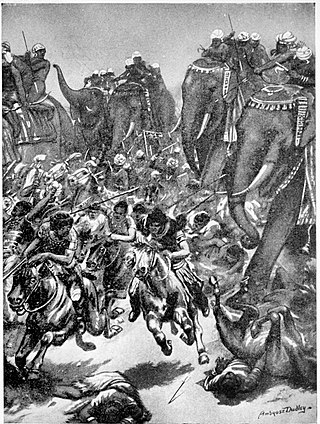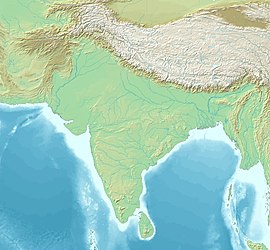The Gupta Empire was an ancient Indian empire on the Indian subcontinent which existed from the mid 3rd century to mid 6th century CE. At its zenith, the dynasty ruled over an empire that spanned much of northern India. This period has been considered as the Golden Age of India by historians, although this characterisation has been disputed by some other historians. The ruling dynasty of the empire was founded by Gupta.
The Kidarites, or Kidara Huns, were a dynasty that ruled Bactria and adjoining parts of Central Asia and South Asia in the 4th and 5th centuries. The Kidarites belonged to a complex of peoples known collectively in India as the Huna, and in Europe as the Chionites, and may even be considered as identical to the Chionites. The 5th century Byzantine historian Priscus called them Kidarite Huns, or "Huns who are Kidarites". The Huna/Xionite tribes are often linked, albeit controversially, to the Huns who invaded Eastern Europe during a similar period. They are entirely different from the Hephthalites, who replaced them about a century later.

The Maukhari dynasty was an Indian dynasty that ruled the Kingdom of Kannauj and controlled the vast plains of Ganga-Yamuna for over six generations from their capital at Kannauj. They earlier served as vassals of the Guptas. The Maukharis established their independence during the mid 6th century. The dynasty ruled over much of Uttar Pradesh and Magadha. Around 606, a large area of their empire was reconquered by the Later Guptas of Magadha. According to Xuanzang, the territory may have been lost to King Shashanka of the Gauda Kingdom, who declared independence c. 600.

Khingila I was the founding king of the Hunnic Alkhan dynasty. He was a contemporary of Khushnavaz.

Eran is an ancient town and archaeological site in the Sagar district of Madhya Pradesh, India. It was one of the ancient mints for Indian dynasties as evidenced by the diverse coins excavated here. The site has 5th and 6th-century Gupta era temples and monuments, particularly the colossal stone boar with sages and scholars depicted on the body of the sculpture. The inscription stones found at Eran are important to reconstructing the chronology of Gupta Empire history. Eran or Erakina was the capital of Erakina (Airikina) Pradesha or Airkina Vishaya, an administrative division of the Gupta Empire.

Toramana also called Toramana Shahi Jauvla was a king of the Alchon Huns who ruled in northern India in the late 5th and the early 6th century CE. Toramana consolidated the Alchon power in Punjab, and conquered northern and central India including Eran in Madhya Pradesh. Toramana used the title "Great King of Kings", equivalent to "Emperor", in his inscriptions, such as the Eran boar inscription.

Budhagupta was a Gupta emperor and the successor of Kumaragupta II. He was the son of Purugupta and was succeeded by Narasimhagupta.
Hunas or Huna was the name given by the ancient Indians to a group of Central Asian tribes who, via the Khyber Pass, entered the Indian subcontinent at the end of the 5th or early 6th century. The Hunas occupied areas as far south as Eran and Kausambi, greatly weakening the Gupta Empire. The Hunas were ultimately defeated by a coalition of Indian princes that included an Indian king Yasodharman and the Gupta emperor, Narasimhagupta. They defeated a Huna army and their ruler Mihirakula in 528 CE and drove them out of India. The Guptas are thought to have played only a minor role in this campaign.

Bhanugupta was one of the lesser known kings of the Gupta dynasty. He is only known from an inscription in Eran, and a mention in the Manjushri-mula-kalpa.

The Alchon Huns, also known as the Alkhan, Alchono, Alxon, Alkhon, Alakhana, and Walxon, were a nomadic people who established states in Central Asia and South Asia during the 4th and 6th centuries CE. They were first mentioned as being located in Paropamisus, and later expanded south-east, into the Punjab and Central India, as far as Eran and Kausambi. The Alchon invasion of the Indian subcontinent eradicated the Kidarite Huns who had preceded them by about a century, and contributed to the fall of the Gupta Empire, in a sense bringing an end to Classical India.

The Sanjeli inscriptions consist in three copperplate charters found in Sanjeli in northern Gujarat, dated to 499 CE, 502 CE and 515 CE respectively: they are the "Sanjeli Charter of the Merchants", "Sanjeli Charter of Bhūta" and the "Sanjeli Charter of Mātṛdāsa". The copperplates mention the rule of Alchon Huns king Toramana in the area, as mahārājādhirājaśrī toramāṇe.

The Eran boar inscription of Toramana, is a stone inscription found in Eran in the Malwa region of Madhya Pradesh, India. It is 8 lines of Sanskrit, the first three of which are in meter and the rest in prose, written in a North Indian script. It is carved on the neck of a freestanding 11 feet (3.4 m) high red sandstone Varaha statue, a zoomorphic iconography of Vishnu avatar, and dated to the 6th century. The inscription names king Toramana, ruler of the Alchon Huns, as ruling over Malwa and records that a Dhanyavishnu is dedicating a stone temple to Narayana (Vishnu).

The Hephthalite silver bowl is a bowl discovered in the Swat region of Gandhara, Pakistan, and now in the British Museum. It dates from 460 to 479 CE, and the images represent two different Huna tribes, suggesting a period of peaceful coexistence between the Kidarites and the Alchons.
The Second Aulikara dynasty was a royal dynasty that ruled over the Kingdom of Daśapura, and at its peak under Yashodharman Vishnuvardhana controlled a vast area, consisting of almost all of Northern India and parts of Deccan plateau. It was the second royal house of the Aulikara clan.

The Battle of Sondani was a large military encounter fought in 528 CE, between the Alchon Hun king Mihirakula and a confederation of Indian rulers led by King Yashodharman of Malwa and King Narasimhagupta of the Gupta Empire.

The Chilek silver bowl is a silver bowl found in the area of Samarkand, and considered as the "best known specimen of Hephthalite art". More specifically, the bowl seems to belong to the Alchon Huns, south of the Hindu-Kush, during the last third of the 5th century CE. The Alchons have long been considered as a part or a sub-division of the Hephthalites, or as their eastern branch, but now tend to be considered as a separate entity.
The Aulikara−Hunnic war was a military conflict between Alchon Huns headed by Toramana and Aulikaras lead by Prakashadharman.

The Kingdom of Daśapura was a kingdom in Central India ruled by the Aulikara dynasty during the classical era and the early medieval era. It was established by Jayavarman in 350 AD. The name Malava Empire is applied to the territorial conquests of Yashodharman, who reigned between 515 and 545 AD.
The second battle of Eran, around 510 CE, marked a significant conflict between Emperor Bhanugupta of the Gupta Empire and the Huna invaders led by Toramana. The battle, commemorated in the Eran inscription, resulted in the death of Bhanugupta's general, Goparaja. It was pivotal in either halting the Huna advance into eastern Malwa or attempting to expel them from the region. The battle marked the first of a series of setbacks for the Huna conqueror. During his struggle against the invader, Bhanugupta may have received support from King Prakāśadharman, the ruler of Mandasor.





























